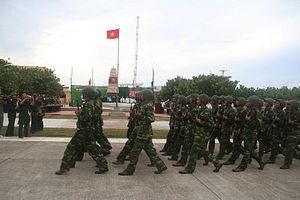Arms imports in the Asia-Pacific surged in 2013, according to a new report.
IHS has released its second annual Balance of Trade report covering the year of 2013. IHS’s data show that imports from East Asia surged nearly 25 percent last year, from $9.8 billion in 2012 to $12.2 billion in 2013.
Meanwhile, IHS reports that “Exports to South, West, and Central Asia rose from USD7.8 billion in 2012 up to USD8.8 billion in 2013.” This export increase was driven primarily by India’s imports rising by $1.8 billion, with many of the additional weapons coming from the United States, including the Boeing P-8 Poseidon maritime surveillance aircraft.
On the other hand, Pakistan’s imports declined by $200 million, from $1.5 billion in 2012 to $1.3 billion in 2013. About 25 percent of this $1.3 billion was in the form of China’s deliveries of the CAC JF-17 fighter to Pakistan. Data from the Stockholm International Peace Research Institute (SIPRI) indicate that China was the source of 54 percent of Pakistan’s arms imports between the years of 2009 and 2013. Beijing also sold Bangladesh an astonishing 82 percent of all its foreign weaponry during the same period. For 2012, IHS Jane’s estimates Bangladesh imported about $350 million worth of arms from China.
The East Asia arms market is also going through some interesting changes, the new IHS data show. For example, despite its burgeoning domestic arms industry, China overtook South Korea as East Asia’s largest arms importer last year. Part of this change was driven by about a $500 million decrease in the value of weaponry that South Korea imported last year compared to 2012. However, China’s arms imports surged by roughly $800 million and topped the amount of arms that Seoul imported in 2012.
A number of Southeast Asian countries also saw their arms imports increase by an appreciable amount. Indonesia’s arms imports tripled, for instance, from $600 million in 2012 to $1.8 billion in 2013. Vietnam’s arms imports also tripled over the last four years, from $300 million in 2009 to $900 million last year. IHS expects Hanoi’s imports to reach $1.4 billion this year and indeed it is being reported by some outlets that Russia has just delivered the second of six Kilo-class submarines it is selling to Vietnam. Last month, Defense Industry Daily said that “Vietnam has reportedly ordered 2 more Gepard Class/ Project 11661K frigates from Russia’s Gorky Shipyard, which will bring their fleet to 6.”
Russia is behind a sizable portion of the increased arms sales to East Asia. According to IHS, Russia’s arms sales increased by nearly a billion dollars year-on-year in 2013, from $2.5 billion in 2012, to $3.4 billion last year. This was achieved on the back of greater sales to China, according to IHS. Still, the U.S. remained the primary arms supplier to East Asia, with $4.1 billion in sales in 2013. This was down slightly from IHS’s estimates of U.S. arms sales to Eastern Asia in 2012.
Meanwhile, South Korea is emerging as a top arms exporter both regionally and across the globe. According to IHS, “Having already overtaken the UK, Italy, and Israel in East Asia, South Korea is forecast by 2016 to generate higher exports revenue in the region than China.” This includes sales to countries like Azerbaijan, Indonesia, Iraq, the Philippines, the United Kingdom, and Turkey. This contrasts sharply with China, whose exports “relied almost entirely on a few economically challenged clients, primarily Bangladesh, Pakistan, and Venezuela.” Altogether, South Korea tallied $600 million in arms sales in 2013, a number that is expected to more than double to $1.5 billion by 2015.

































